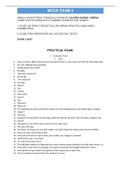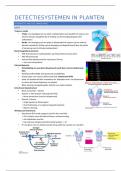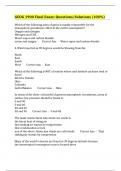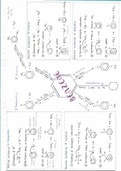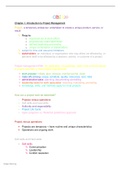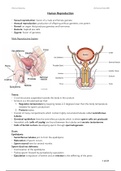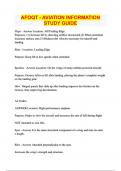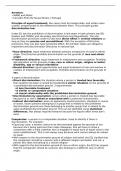REHABILITATION
TECHNOLOGY
Academiejaar 2023-2024 – 2 MARE
H1. BODYWEIGHT SUPPORTED, ROBOTIC AND VIRTUAL
REALITY APPLICATIONS DURING GAIT REHABILITATION –
VUB
H2. TECHNOLOGY-BASED ASSESSMENT AND TRAINING
FOR PARKINON’S – KUL
H3. TECHNOLOGY SUPPORTED UPPER LIMB
REHABILITATION – UH
H4. ROBOT-ASSISTER THERAPY IN NEUROLOGICAL
REHABILITATION – UH
H5. MOTOR LEARNING IN THE CONTEXT OF TECHNOLOGY-
SUPPORTED REHABILITATION – UH
H6. MUSIC TECHNOLOGY IN NEUROLOGICAL
REHABILITATION – UH
H7. M-HEALTH IN TELEREHABILITATION – UH
, Rehabilitation technology
CHAPTER 1: BODYWEIGHT SUPPORTED, ROBOTIC AND VIRTUAL REALITY APPLICATIONS
DURING GAIT REHABILITATION - VUB
Gait training/rehabilitation is different for different types of neurological patients and depends on the
severity of the disorder / limitations of the patients.
First look at patient, then see which technological device can be used for this patient/ disease
and not the other way around
o What can be used as a possible solution for (the problem of) my patient
➢ Technology pushed = NOT what we want
➢ Patient-centred = what we want → look at their request for help
Different types of gait training:
- Overground training
- Overground training with body weight support: walk together with P and device in practice
- Overground training with robot-assistance (exoskeleton devices)
- Treadmill training
- Treadmill training with body weight support
- Treadmill training with robot-assistance (exoskeleton devices / end-effector devices)
CASUS
Mrs. De Vries is a 76-year-old retired woman who used to be a saleswoman. She is an active lady
who loves walking with her dog, visiting her friends and dancing with her husband. On Tuesday,
September 5, 2019, Mrs. de Vries had agreed to meet a friend at 10 am. Her husband had left early
that morning for the local market. However, Mrs. de Vries did not show up and her friend became
worried. During her lunch break (around noon) her daughter went to see her mother and found her
lying on the ground in the kitchen. Around the same time, Mr. De Vries also returned home. Mrs.
De Vries lay unconscious on the floor and there was an unpleasant smell in the kitchen. The daughter
immediately called an ambulance, after which Mrs. de Vries was taken to the nearest hospital.
There she first went to the intensive care unit, after which a surgical thrombectomy was performed
(left cerebral artery area). Subsequently, Mrs. de Vries was transferred to the stroke unit.
Status 5d • ROM: normal left and right
post-stroke • Muscle strength
• Right arm: proximal 2/5, distal 2/5
• Right leg: global 2/5
• Gait pattern: patient needs firm continuous support from therapist (FAC 1) →
indicates she needs a lot of help/support
• Motricity Index: Upper limb 39/100; Lower limb 37/100
• Berg Balance Scale: 6/56 → indicates balance problems
• Trunk control test: 62/100
• Barthel Index: 46/100 → indicates that she is not independent in ADL
• No spasticity
• No sensory problems
Request for Mrs. De Vries hopes that in the future she will no longer be dependent on others (for
help ADL and hygiene).
1
,How can we increase the effect of neurorehabilitation?
➢ Task-specific training: train to regain a specific task/function (e.g., cooking, walking…)
➢ High intensity with a high number of repetitions: train on a daily base
➢ Goal-oriented training: train to reach a goal
1/ BODYWEIGHT SUPPORT SYSTEMS
Different systems for BWS training:
- Differences in suspension-system → difference in stability (1 point, 2 points…)
o 2 when more stability is needed, in P with a more severe condition
o 1 for more functional exercises (more trunk rotation), less limited to train balance or
in upper limb training
- Differences in harness (sizes, straps…)
- Differences in suspension type (static, passive, dynamic…)
Different instruments:
ANDAGO:
• Un-weight differently on both sides
• Sensors in the system to follow the body during walking (follow you when you want to turn)
BIODEX:
• T possibility to sit on the frame and help P with moving
ZERO G:
• Not with a frame, but a rail system → P can walk in the system
• Very good adaptation on the gait pattern
• Not just for walking, also for balance exercises
LITEGAIT:
• Not complex, easy to use and also possible for children
HIBBOT:
• Upper limb is free (can use hands for daily activities)
• Trunk position is upright
• System is behind then, less confrontation
• The device does not limit the gait function (stride length or gait speed)
• When talking to other people, there is no system between patient and other people
(e.g., patient can play normally together with other children)
SAIRE SMART WALKER:
• Smart devices and Artificial Intelligence for Rehabilitation
• Affordable equipment, no sensors on user, real-time gait analysis, real-time feedback
Advantages
➢ Less compensatory strategies (more symmetry)
➢ Increased walking speed and safety
➢ Less fear and risk of falling
➢ Gait training even if the patient can no more/not yet walk
➢ Task-specific training with high number of repetitions (more steps)
Disadvantages
➢ Labour intensive for therapist: number of staff, low at the ground (not very ergonomic)
➢ Sometimes not moveable
➢ BWS: 45-50% influences walking pattern (toe-walking), changes in thorax-pelvis biomechanics
o Harness: less vertical acceleration
2
, o BWS: less acceleration in 3 directions, less inter-segmental coordination of thorax and
pelvis, less amplitude in muscle activity
Optimal setting: Often: 30-40% of the body weight at a low walking speed (0,1 tot 0,3 m/s) and increase
gait speed, walking distance, duration, and reduce body weight support to 0%
Risk when you have very high levels of bodyweight support:
➢ Less countermovement of the lower body and less movement of the upper body
➢ Very passive for patient
➢ P will not have a normal heel strike (will touch the ground with the front of the foot) = toe-
walking
Evidence
❖ Stroke (44 trials with 2658 participants)
• Treadmill with or without BWS compared to no treadmill training
o Not more likely to improve their ability to walk independently
o Walking speed and walking endurance may improve
• Patients that are able to walk benefit most → use these systems only in P with a certain gait
function
❖ Parkinson’s disease (18 trials with 633 participants)
• The use of treadmill training may improve gait speed and stride length
• Physiotherapy with treadmill training in the treatment of gait hypokinesia seems to be more
beneficial in practice without increased risk
❖ Multiple sclerosis (8 trials with 161 participants)
• Improvements in walking speed and maximum walking distance after treadmill training with
or without bodyweight support.
• Improvements in stride length, double support time and EDDS, but no evidence that treadmill
training gives the best results.
CASUS: Could body weight supported and/or robot-assisted gait training be useful for this patient?
- Now in the acute phase?
- Later in the subacute or chronic phase?
Not useful, because patient is not able to walk yet
Not much evidence in these patient-population
Still some advantages:
o To read
o For the blood pressure
o To avoid that P sits all day long
2/ ROBOT SYSTEMS
3
TECHNOLOGY
Academiejaar 2023-2024 – 2 MARE
H1. BODYWEIGHT SUPPORTED, ROBOTIC AND VIRTUAL
REALITY APPLICATIONS DURING GAIT REHABILITATION –
VUB
H2. TECHNOLOGY-BASED ASSESSMENT AND TRAINING
FOR PARKINON’S – KUL
H3. TECHNOLOGY SUPPORTED UPPER LIMB
REHABILITATION – UH
H4. ROBOT-ASSISTER THERAPY IN NEUROLOGICAL
REHABILITATION – UH
H5. MOTOR LEARNING IN THE CONTEXT OF TECHNOLOGY-
SUPPORTED REHABILITATION – UH
H6. MUSIC TECHNOLOGY IN NEUROLOGICAL
REHABILITATION – UH
H7. M-HEALTH IN TELEREHABILITATION – UH
, Rehabilitation technology
CHAPTER 1: BODYWEIGHT SUPPORTED, ROBOTIC AND VIRTUAL REALITY APPLICATIONS
DURING GAIT REHABILITATION - VUB
Gait training/rehabilitation is different for different types of neurological patients and depends on the
severity of the disorder / limitations of the patients.
First look at patient, then see which technological device can be used for this patient/ disease
and not the other way around
o What can be used as a possible solution for (the problem of) my patient
➢ Technology pushed = NOT what we want
➢ Patient-centred = what we want → look at their request for help
Different types of gait training:
- Overground training
- Overground training with body weight support: walk together with P and device in practice
- Overground training with robot-assistance (exoskeleton devices)
- Treadmill training
- Treadmill training with body weight support
- Treadmill training with robot-assistance (exoskeleton devices / end-effector devices)
CASUS
Mrs. De Vries is a 76-year-old retired woman who used to be a saleswoman. She is an active lady
who loves walking with her dog, visiting her friends and dancing with her husband. On Tuesday,
September 5, 2019, Mrs. de Vries had agreed to meet a friend at 10 am. Her husband had left early
that morning for the local market. However, Mrs. de Vries did not show up and her friend became
worried. During her lunch break (around noon) her daughter went to see her mother and found her
lying on the ground in the kitchen. Around the same time, Mr. De Vries also returned home. Mrs.
De Vries lay unconscious on the floor and there was an unpleasant smell in the kitchen. The daughter
immediately called an ambulance, after which Mrs. de Vries was taken to the nearest hospital.
There she first went to the intensive care unit, after which a surgical thrombectomy was performed
(left cerebral artery area). Subsequently, Mrs. de Vries was transferred to the stroke unit.
Status 5d • ROM: normal left and right
post-stroke • Muscle strength
• Right arm: proximal 2/5, distal 2/5
• Right leg: global 2/5
• Gait pattern: patient needs firm continuous support from therapist (FAC 1) →
indicates she needs a lot of help/support
• Motricity Index: Upper limb 39/100; Lower limb 37/100
• Berg Balance Scale: 6/56 → indicates balance problems
• Trunk control test: 62/100
• Barthel Index: 46/100 → indicates that she is not independent in ADL
• No spasticity
• No sensory problems
Request for Mrs. De Vries hopes that in the future she will no longer be dependent on others (for
help ADL and hygiene).
1
,How can we increase the effect of neurorehabilitation?
➢ Task-specific training: train to regain a specific task/function (e.g., cooking, walking…)
➢ High intensity with a high number of repetitions: train on a daily base
➢ Goal-oriented training: train to reach a goal
1/ BODYWEIGHT SUPPORT SYSTEMS
Different systems for BWS training:
- Differences in suspension-system → difference in stability (1 point, 2 points…)
o 2 when more stability is needed, in P with a more severe condition
o 1 for more functional exercises (more trunk rotation), less limited to train balance or
in upper limb training
- Differences in harness (sizes, straps…)
- Differences in suspension type (static, passive, dynamic…)
Different instruments:
ANDAGO:
• Un-weight differently on both sides
• Sensors in the system to follow the body during walking (follow you when you want to turn)
BIODEX:
• T possibility to sit on the frame and help P with moving
ZERO G:
• Not with a frame, but a rail system → P can walk in the system
• Very good adaptation on the gait pattern
• Not just for walking, also for balance exercises
LITEGAIT:
• Not complex, easy to use and also possible for children
HIBBOT:
• Upper limb is free (can use hands for daily activities)
• Trunk position is upright
• System is behind then, less confrontation
• The device does not limit the gait function (stride length or gait speed)
• When talking to other people, there is no system between patient and other people
(e.g., patient can play normally together with other children)
SAIRE SMART WALKER:
• Smart devices and Artificial Intelligence for Rehabilitation
• Affordable equipment, no sensors on user, real-time gait analysis, real-time feedback
Advantages
➢ Less compensatory strategies (more symmetry)
➢ Increased walking speed and safety
➢ Less fear and risk of falling
➢ Gait training even if the patient can no more/not yet walk
➢ Task-specific training with high number of repetitions (more steps)
Disadvantages
➢ Labour intensive for therapist: number of staff, low at the ground (not very ergonomic)
➢ Sometimes not moveable
➢ BWS: 45-50% influences walking pattern (toe-walking), changes in thorax-pelvis biomechanics
o Harness: less vertical acceleration
2
, o BWS: less acceleration in 3 directions, less inter-segmental coordination of thorax and
pelvis, less amplitude in muscle activity
Optimal setting: Often: 30-40% of the body weight at a low walking speed (0,1 tot 0,3 m/s) and increase
gait speed, walking distance, duration, and reduce body weight support to 0%
Risk when you have very high levels of bodyweight support:
➢ Less countermovement of the lower body and less movement of the upper body
➢ Very passive for patient
➢ P will not have a normal heel strike (will touch the ground with the front of the foot) = toe-
walking
Evidence
❖ Stroke (44 trials with 2658 participants)
• Treadmill with or without BWS compared to no treadmill training
o Not more likely to improve their ability to walk independently
o Walking speed and walking endurance may improve
• Patients that are able to walk benefit most → use these systems only in P with a certain gait
function
❖ Parkinson’s disease (18 trials with 633 participants)
• The use of treadmill training may improve gait speed and stride length
• Physiotherapy with treadmill training in the treatment of gait hypokinesia seems to be more
beneficial in practice without increased risk
❖ Multiple sclerosis (8 trials with 161 participants)
• Improvements in walking speed and maximum walking distance after treadmill training with
or without bodyweight support.
• Improvements in stride length, double support time and EDDS, but no evidence that treadmill
training gives the best results.
CASUS: Could body weight supported and/or robot-assisted gait training be useful for this patient?
- Now in the acute phase?
- Later in the subacute or chronic phase?
Not useful, because patient is not able to walk yet
Not much evidence in these patient-population
Still some advantages:
o To read
o For the blood pressure
o To avoid that P sits all day long
2/ ROBOT SYSTEMS
3

